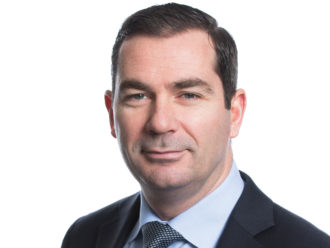Richard Tomlinson, Local Pensions Partnership’s new chief investment officer, tells Mona Dohle, about why this crisis is different, the outlook for the global economy and that this is no time to act like a hero.
How has Covid-19 impacted LPP?
It’s been an interesting few weeks to say the least. Our portfolios have seen some large price moves, but in terms of the operation we haven’t had any issues so far. I am sure many others are in a similar position in that we have gone from an office-based environment to a remote environment in an accelerated timeframe. Thanks to our IT team, we are operating fully remotely which we could not have done a few weeks ago. It’s been a team effort.
That might be quite useful in the long run then? Rahm Emmanuel (chief of staff at the White House) used to say: “Never let a crisis go to waste.” This is the same situation; we’ve had a significant upgrade in our IT infrastructure which we might have made in the long term, but this has accelerated it massively. It’s fair to say that we’ve learnt a lot about ourselves, as have many organisations. The key is to focus on communication within the team, which is much harder if you’re not in the same room. It is also forcing us to be more disciplined in terms of how we communicate, especially if other support functions like childcare have disappeared.
Was your portfolio relatively well prepared for an event such as this?
Were we prepared for a pandemic? Clearly, we weren’t. Were we concerned about market structures, liquidity management and the setup we have in public markets? Certainly. Some of the big swings we have seen recently were not that surprising given how the market structure has changed over the past decade in terms of who holds what capital and how it’s leveraged. The underlying liquidity provision, the way markets function now and the role investment banks play in a crisis is not particularly surprising. Black Swans enlarge many standard deviations in markets. I thought we would see some flash crashes, but this has been more significant. We’ve had significant deleveraging of positions in many places. The whole ETF complex is in the spotlight now which isn’t surprising.
I’ve flagged issues around high-yield ETFs before, but I didn’t think it would hit investment-grade bonds in some of the areas it has. In equities we have seen significant movements. When you look at the way markets operate it is not that surprising. If you think about who provides liquidity in these markets now and the way their risk management works it is not surprising that liquidity shut down when things got as large as they did.
ETFs have had a detrimental effect on market liquidity?
Liquidity in good times is better than it was, but, as market depth has imploded, in stressed conditions liquidity evaporates. The reason is that banks cannot warehouse significant amounts of risk now. Banks aren’t there to provide liquidity anymore because of capital requirements and constraints on their balance sheets, which has changed massively. A lot of liquidity is now provided by hedge funds and high-frequency traders and many of those businesses run themselves with similar risk management profiles and can simply shut down if they don’t like the opportunity set in front of them.
So market makers are acting more like proprietary traders and liquidating their most liquid assets?
Absolutely. We have observed that highly liquid assets moved the most. That is of course completely understandable, if you have large top-down liquidations people try to shift risk using index positions, derivatives and potentially ETFs. The quickest way to hedge that is to pick a basket of liquid index constituents. You wouldn’t trade in the smaller or mid-cap range.
What is driving these massive swings in equities and bonds?
There are short and long-term, as well as technical, sentiment and fundamental, factors at play. Part of the change is a more long-term, fundamental shift in outlook, whether that be with regard to interest rates and inflation or the fundamental damage of the virus to the long term prospects of the economy.
But what has made volatility extreme over the short term is the sentiment factor, which has changed quickly, leading to enormous outflows. One key factor which hasn’t been talked about enough is that as volatility rises, many investors have had risk management processes in place which responded to that input. Processes are now often conditioned on several market-based factors so if volatility rises, it tends to lead to the sale of certain assets.
People have pointed the finger at risk-parity programmes, which is reasonable. As volatility has risen, many risk-parity programmes had to deleverage, which led to wholesale selling of pretty much every asset creating a vicious effect. Risk-parity programmes are, of course, not the only factor in that, but it is clearly the cue to deleveraging. It is important to remember that these are short-term factors. There will probably be further selling ahead but the key question when deciding where to invest long term is what do the fundamentals look like.
What has been the short-term impact on LPP’s investment portfolio and have you made any changes in asset allocation?
Coming into this shock, we were cautious. Whilst we have seen pretty good markets for more than 10 years as central banks have provided a strong tailwind; at the back of our minds we knew that valuations were stretched and that a lot of good news was already priced in. Add to that the liquidity concerns I spoke about earlier. That is not to say we were broadly in line with our long-term strategic asset allocation; we weren’t overweight on risk assets, but we weren’t underweight either. The challenge is that it’s easy to predict that the world is coming to an end. How many times have people called for the end of the world over the past decade and central banks kept pushing forward to drive markets higher?
The situation we find ourselves in yet again is something I must admit I didn’t quite grasp back in 2008. When the problem is big enough, when the system is threatened, when politicians are threatened, when society is threatened, anything is possible. The rules of the game can simply be rewritten. It happened in 2008 and it is starting to happen again. Governments can change primary legislation; they can dust off laws that haven’t been used in 300 years. This problem is big enough. The world is focused on finding solutions to the virus, whether it’s developing vaccines or building ventilators quickly. The way we are thinking about this in terms of the impact on our portfolio is that we have to manage the short-term risk. For pension schemes like ours, because our liabilities tend to be long dated, the focus is on managing liquidity and making sure we have cash to meet our liabilities in the short term.
We also have to manage the long-term funding levels and be prudent in our portfolio management. We have an advantage over many other market participants in that we can absorb short-term liquidity and we are able to have a long-term perspective and stable balance sheets.
Is that because as an LGPS pool you have a relatively younger membership compared to the average DB scheme?
There are multiple factors. We are an open scheme, unlike most DB schemes. If you are in the DB business, you will be in one of two camps, with some shades of grey. If you are a closed scheme, you will be facing an endgame, trying to get some form of surety on meeting your liabilities with as much certainty as possible as quickly as possible. If you are an open DB scheme, like the LGPS, with a strong covenant, it is different. We are a quasi-perpetual investor. We are not in an end-game run-off scenario. The duration of our liabilities is in excess of 20 years, so we can take a longer-term view.
So are there buying opportunities around?
That’s the million-dollar question. There may be some interesting opportunities developing but I would be cautious as this year could be interesting in certain pockets. Assets are cheaper and a lot of bad news has been priced in, but I wouldn’t make the Herculean call to say that we have reached a bottom. I would urge caution on attempts to try and call a bottom at this point until we have more clarity on the depth and length of the economic pain inflicted by the virus. What you can say is that you have enormous policy support. Central banks and policymakers will continue to do whatever it takes. A turning point will be when the lockdowns end because they are causing significant economic damage.
The 2008 crisis started unfolding in the financial sector whereas this crisis has hit the real economy directly.
Absolutely. In some ways the real economy is less equipped to deal with such shocks. In the financial sector, central banks can deal with finance, liquify banks, address IG spreads and rewrite solvency rules. Regulators and central banks can do all of that quickly, but it is much harder to support small, privately-owned businesses which have been forced to close.
Governments and policymakers could, of course, help to address this but the logistical challenge, especially with most people working from home and infrastructure not being geared up to work remotely, is more complex. There will be a way through this but it’s going to take a little more time. What I am watching out for primarily is the situation in the US and to what degree it is deteriorating.
US labour market figures from the end of March suggest further deterioration with
6.6 million people filing for unemployment benefit…
It has been slightly overused, but the old adage, ‘when the US sneezes the world catches a cold’ is still relevant. Once we can see how the US will get through this, and it is a question of when, we will see a significant resurgence of confidence in the global outlook.
So the question is will the crisis last for weeks, months or, perhaps, years? From a financial markets point of view, the fireworks we have seen will start to come under control. There is another widely used saying that comes to mind, ‘when central banks panic, markets start to calm down’. That does not mean that the real economy will recover at the same pace. I am talking quarters here, hopefully not years. We discussed this with our senior investment managers to see how we’re viewing the continuum of probabilities between a V shaped, U-shaped or L-shaped recovery. The V-shaped is looking less likely, the U shaped is somewhat of a probability and the L-shaped is somewhere in the middle. Markets could see a V-shaped recovery if central bankers are successful, but we will see the damage to the real economy for quite some time.
What could asset managers and consultants do to help steer pension funds through this crisis?
First, good communication. Second, don’t panic. Third, evidence-based decision making. Fourth, don’t try to be a hero by making big calls on market tops and bottoms. There is huge uncertainty in what we are dealing with here. If you told me eight weeks ago that we’d be able to buy US investment-grade credit at index level 300 basis points plus, I would have said, “I’m in”. Now I won’t make a market view, which has more to do with policy rather than the underlying credit quality. You have to be mindful of that while there are assets around that look incredibly appealing based on price that we are in a different paradigm. People using models conditioned on the last 10 years’ worth of data need to be careful, especially with those who started managing money after the last crisis.
What will the world look like in a few years’ time?
With luck we will have established a clear way of dealing with the virus and the issues around it. Life will hopefully return to normal. This could potentially be resolved by the end of the year but the effects on the economy could linger on for longer. I hope markets stabilize and return to normal levels. You’d hope that this won’t inflict too much damage on the real economy but there are many businesses that won’t be around in a few years. We are at the stage where policymakers are discussing on what terms they are going to save businesses and that is potentially going to be defining for this crisis.
We will come out of this crisis, but some businesses, depending on where policymakers sit, could end up with different capital structures. From one extreme, the nationalisation of airlines. Either way, we must make sure the recovery is fair. That is going to be loud and clear in many politicians’ minds. So there will be a lot of challenges around how bailout programmes are structured and how small businesses will be supported. I feel for people whose business or income has almost evaporated overnight.
In 2008 there was a paradigm shift in the way the State interfered in the financial sector. Could we see such interference in the real economy this time?
I am not making any predictions here but just think about airlines and government policy on climate change and what might win political kudos? Who knows? Don’t underestimate human ingenuity, you have to be hopeful that this too shall pass.
This interview was conducted as part of the portfolio briefings series. It is also available as video interview and podcast.




